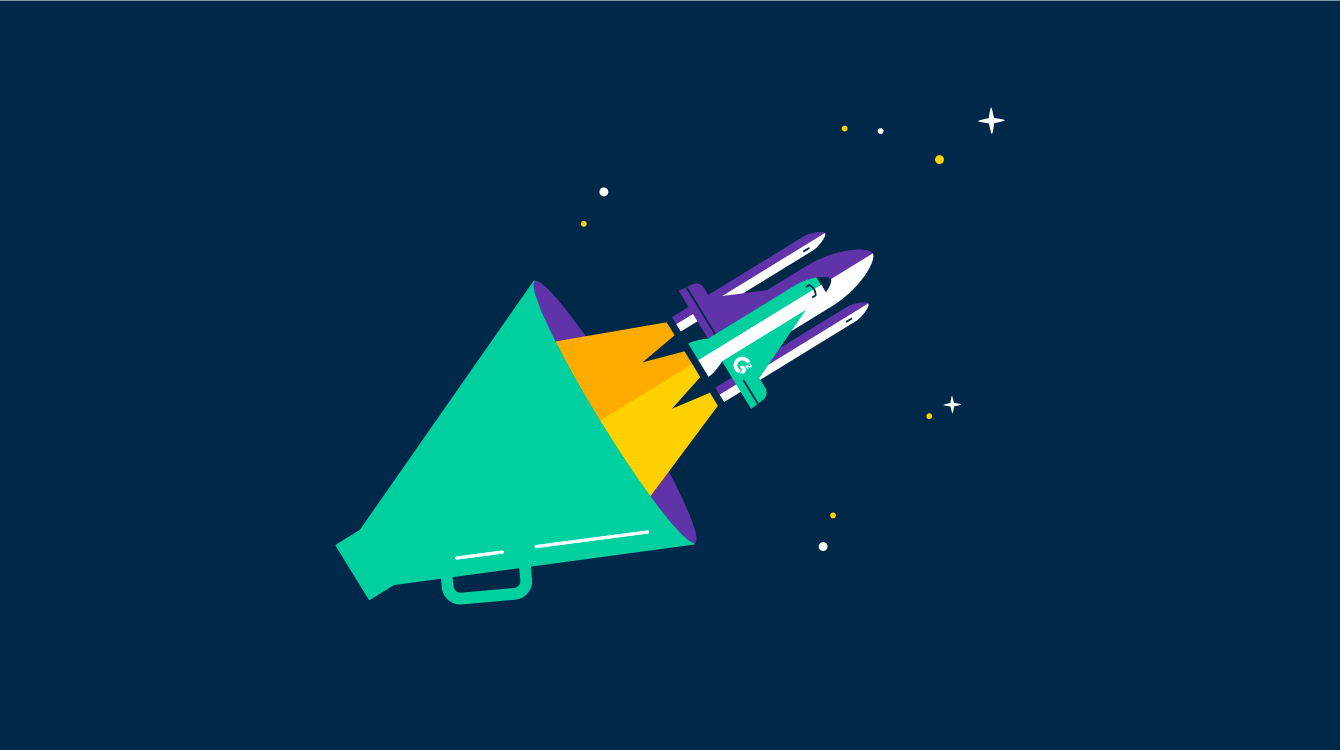February 20, 2020
 by Daniella Alscher / February 20, 2020
by Daniella Alscher / February 20, 2020

Running marketing campaigns is the main way that businesses can both communicate with their audience and acquire new leads.
But launching one is easier said than done. Putting together a marketing campaign takes time, effort, organization, and awareness, among other things. They’re also an enormous risk; one misstep, one off-taste response, or one poorly-timed launch could ruin your brand forever.
A marketing campaign is a planned, organized sequence of activities designed to bring new revenue or awareness for a product or service. More often than not, marketing campaigns are run across several different channels as opposed to a single channel to maximize exposure to the desired audience.
Marketing campaigns often take place across multiple mediums in which a wide array of marketing metrics are monitored to reach one or several overarching goals. While some of them look effortless, the best marketing campaigns are often well thought-out, follow a theme, and are expertly executed.
Before learning the process of launching a marketing campaign, it's crucial to become familiar with marketing campaign management.
Any noteworthy marketing campaign involves many moving projects, people, and ideas. Marketing campaign management is all about keeping those things organized, turning them into an actionable plan, executing that plan, and tracking the appropriate metrics.
Marketing campaigns don't often appear in just one place; social media posts, television commercials, emails, promotional materials and more are all focused around one idea in order to get your audience to take action. The more points of exposure an audience has, the more chance there is that they'll take the desired action.
Understanding your audience isn't just the key to any marketing campaign; it's the key to the success of a business. Being able to identify the problems they're experiencing, the topics they're interested in, and what excites them are the stepping stones towards turning strangers into loyal customers.
Launching a marketing campaign is an enormous feat, and a campaign manager is the person who sees it through. The campaign manager is often communicating with both sales and marketing teams to ensure that the campaign aligns with the goals of both teams in a creative and unique way.
While it's not mandatory that a campaign manager be in place to launch the campaign, having someone oversee everything from a higher level has proven to be helpful.
Campaign managers should:
There’s no official playbook when it comes to planning and launching a marketing campaign. For the sake of this article, we’ll list out the process of marketing campaign creation in four categories.

In the first stages of a marketing campaign, ideas are only beginning to come to the surface. The ideation phase is when you and your team gather all of those ideas, identify who they’re for, what you want to do with them, and how you’ll implement them into your actual campaign.
The first thing that your marketing team should do is clearly identify what you’re trying to achieve with this campaign. Each and every campaign should be launched with purpose.
There are several different types of marketing campaigns. Are you trying to:
It’s not enough to choose one of these bullet points and restate it as a goal. For example “we want to launch a new product” is far too generic for anyone to be able to follow through and call the end result a “success”. Instead, marketers should be focused on creating goals that are SMART.
SMART is an acronym that stands for Specific, Measurable, Attainable, Relevant, and Time-based. Working around this acronym ensures that there will be several ways to hold yourself accountable for hitting the mark.
So, instead of simply wanting to "promote an event" with no way to measure that success, get SMART:
| Specific | A Q2 promotional event |
| Measurable | 400 registrants |
| Attainable | Providing a link to a landing page for via Instagram and Twitter |
| Relevant | Promoting your latest product (Product X) |
| Time-based | By the end of Q1 |
“We want to promote our Q2 promotional event for our latest product (Product X) via Instagram and Twitter, with a goal of getting 400 people to register by the end of Q1” is a much clearer goal than what we started with.
Getting into the nitty-gritty of your campaign goal will leave less room for error, and more room for success.
Once you’ve determined a goal and made it SMART, begin thinking about your campaign’s audience. Before your team even starts to think about demographics, think about the relationship you’ll have to the audience of this campaign.
Will these people recognize your brand, or do they not even know you exist? Are you trying to get new customers or continue to nurture existing ones? Where is your campaign’s audience in the buyer’s journey?
The marketing materials you’ll be creating for your campaign depend heavily on this answer. For some campaigns, there may be more than one answer; your audience could have some members at one stage and others in another stage. This means that sometimes it’s appropriate to create versions of literature for each stage.
Once their position(s) within the sales funnel has been determined, it’s time to narrow your audience down even further.
The narrower you keep your audience, the easier it can be to deliver a message that they’ll not only remember, but also create a call-to-action that will resonate with them and encourage them to take the next step, whatever it may be.
Now that you and your team have decided on your goal and determined the audience you’d like to achieve that goal with, the next step to take is to figure out exactly how to do that. One of – if not the most creative step in the marketing campaign process – is ideating concepts that will hit home with your audience.
From broad subjects like determining what the campaign is going to try and achieve and what message it’s sending, to the visual identity of the campaign and the language being used within it, every little detail about the concept should be fleshed out.
Not only will your team have to come to an agreement with the overall look and feel of the campaign, but they’ll also have to take things a step further and decide how those things will be accomplished.
Deciding which copywriter, video producer, graphic designer, or other creative is no easy task. Between in-house, agencies, and freelancers, the decision is up to you, your team, and most importantly, your budget.
By no means does this step happen quickly. Creating a marketing campaign is like creating an entire miniature brand, and it’s most definitely something that shouldn’t be rushed. Most of the greatest campaigns didn’t come to fruition in seconds – yours shouldn’t either.
Most of what’s been discussed thus far has revolved around looking forward and making decisions based on the information you’ve collected for this specific campaign. Don’t forget that there’s no harm in looking left, right, and backwards, too.
Whatever you’re campaigning for, it’s not unlikely that it hasn’t been done before. But has it been done well?
Take a look at the promotion campaigns that your competitors have executed in the past, and jot down some notes about the things you and your team admire, as well as the things that you’ll try to stay away from. Know that these notes should not be used to duplicate exactly what other marketers have done, but to ensure that you do the opposite and create something completely fresh.
Once you’ve analyzed the decisions your competitors have made, it’s time to take a look at your own. Unlike competitor campaigns, you have the results of your past campaigns in your back pocket.
What were they? What things have gone well or even exceeded your expectations in the past? What are some things that you’ve tried before that haven’t gone well or have completely failed?
Taking this knowledge with you as you’re conceptualizing makes for more intelligent and informed decision making.
Any marketer knows that the ideation phase has no end. Once your ideation phase has come to a place where you feel you can begin to move forward, it’s time to start the plan.
In this phase, your marketing team will be taking note of everything that needs to be done for the campaign to be launched successfully, as well as when those tasks need to be completed.
The more we move forward with technology, the more platforms become available for marketers to execute their campaigns. Depending on your budget and the amount of time you’ve given your team to execute, there’s a chance that the sky truly is the limit; while one medium may stand out to you and your team, integrated marketing campaigns often outperform those campaigns that only use one platform.
Choosing which channel(s) you’ll execute your campaign on and developing a marketing campaign strategy can be tricky; it takes strategic thought in order to make the choices that will result in the best possible outcome. Think of your target market, and choose the platforms that you know they’re most active on.
Below are some examples of the platforms that you could take on.
| Paid | Earned | Shared | Owned |
| PPC - social, SERPs, etc | PR outreach | Referrals | Newsletter |
| Print ads | Outreach to contacts | Forums | Website |
| Display ads | Interviewing with publications and influencers | Forums | Email campaign |
| Sponsorships | Reviews | Social media | |
| Influencers | Word of mouth | Blog | |
| TV ads | Whitepapers |
Looking for a way to gain more earned media? Creating a G2 profile gives your customers a platform to leave reviews – and they’re all yours for your next campaign.
The way you and your team define success depends on the goals you’ve set for yourself as well as the channels you’ve selected to achieve those goals. There are plenty of marketing metrics that your team can choose from, and avoiding vanity metrics isn’t always easy.
Making sure that your KPIs are actionable is crucial for both the reports that you’ll produce after the campaign as well as for the next campaign that you run. Measuring fluffy metrics may look great on paper, but they often have little to do with the ultimate goal of the campaign, and therefore are not as relevant to your success as other, sometimes harder-to-swallow metrics.
The focus of your campaign is what it’s all about. Your campaign shouldn’t just be about showing off a new product or telling people about an upcoming event. Think about what action you want your audience to respond with, and develop a CTA to encourage that type of response.
Your CTA should be an even exchange between you and your audience. The action that they take should be one that helps you hit your ultimate goal, but it should also be one that gives benefit to your audience.
For example, asking someone to submit their email to a lead form is rewarding for you, but what can you give them in exchange? Incentivize your audience — provide them with educational materials, a discount, or even a chance to be featured on that very same home page in exchange for what they’re giving you.
This “exchange” idea is applicable to any type of campaign. If you want your audience to take action, tell them how they’ll benefit from it, too.
Now that you’re aware of what needs to be done, it’s time to determine who’s going to do it. Marketing campaign management is never truly a one person job; it’s a team effort.
Depending on the channels you’ve chosen, there’s a chance that the tasks at hand could be executed in-house. For example, if you’re choosing to increase engagement, developing a social media strategy and carrying that out is something that has the potential to be taken care of without needing any external consultants.
However, there are such things as small businesses, teams of limited sizes, or simply a lack of resources. For example, don’t let your lack of knowledge for videography stop you from wanting to create a video ad. If you have the budget, freelancers and agencies are at your creative disposal to work with you to get exactly what you’re looking for if you don’t have the means to do it yourself.
The first deadlines you should be setting are the start and end dates of your campaign. Doing this allows you and your team to work within a time frame as opposed to having to set dates with no end in sight.
Once those dates are set, take a look back at the mediums your team has decided to move forward with. Determine how often you can promote your content based on the time you’ve allotted yourself, the budget you have for the campaign, and the resources you have.
For example, if you’ve chosen to do a campaign solely on social media, plot out all of the dates that you’ll be promoting your campaign, down to the minute. If your team has chosen to invest money in a billboard, it’s going to take a different kind of planning to determine when to have a design ready, when to contact a media buyer, and so on.
No matter what platform(s) you’re promoting on, using project management software is absolutely necessary.
This software displays the various deadlines, which can help you and your team truly visualize the space between each launch date. Doing this will ensure that every launch is being spread out evenly and will also help you when you take a look at your campaign after it’s over.
Once everything is mapped out on your timeline, your team is comfortable with the project managers and the platforms they’ll be managing, and the CTA you’ll be providing for your audience is made, it’s time to launch.
The execution phase of a marketing campaign isn’t as simple as pushing the big red button. The purpose of launching a campaign is to grab your audiences’ attention and persuade them to take action. Let’s say they do take that desired action – how do you move forward?
Newton’s law says that for every action, there is an equal and opposite reaction. It’s true in physics, and it should be true in marketing, too.
When you ask your audience to take action, react when they do. If you’re promoting a product launch, give them a demo. If you’re asking people to register for an event, follow up with some additional content about what they should expect. If you’re looking for more engagement on social media, return the favor and engage with those who do.
Planning and launching your campaign is just half the fun – monitoring and analyzing the information that comes from that campaign is the other half. The results that you get from that data can provide you with insight into your audience, the channels you used to reach them, and the way your budget was spent.
Not only is this helpful when you’re reporting results to managers and stakeholders, but it’s also important to have that information in your back pocket for when you launch your next campaign.
Marketing automation software can help your marketing team create and launch campaigns, but it’s also capable of tracking the resulting metrics of those efforts. Taking a look at these numbers throughout your campaign, and especially as it’s coming to a close, is what will tell you whether or not you hit your SMART goals.
This doesn’t involve simply looking at one metric. Any medium with which you executed your campaign has analytics that come with it. Email, social, website, and any other platform data that you’ve collected over the course of your campaign can help you collect customer analytics regarding behavior, opinion, and more so that your next campaign can be launched to fit their tastes more accurately.
It’s important to look ahead at future projects, but how can you launch those successfully without taking a look at your past efforts? Holding a meeting to look at the campaign that was just executed, successful or not, is crucial to the success of your future campaigns.
Sit down with your team and ask them (and yourself):
Based on the answers, your team will decide on the actions they can take to optimize campaigns in the future.
Holding a retrospective isn’t a required part of the marketing campaign process, but it’s certainly helpful for not only calling out the success you and your teammates experienced, but also the obstacles you need to overcome in the future.
Without a retrospective meeting, there’s a chance that your team will make one (or more) of the common mistakes below.
Competitor analysis is a tricky thing, but it has to be done. Ignoring your competition altogether means that you could be missing out on something they’ve done extremely well, as well as something they’ve done very poorly.
This is not to say that you should then be copying exactly what they’ve done well and avoiding everything that they executed poorly. Instead, look at your competitor to see what’s been done: the good, the bad, and the ugly.
Regardless of how those campaigns went, it’s your job to make your campaign different; a successful marketing campaign is never a repeat of another. What is it about you that’s different than your competition? What makes your product different from the rest?
The message that marketers decide to send out into the world about what it is they’re promoting can sometimes be so monumental, so exciting, that tying in the brand itself is sometimes forgotten. Even if not completely lost, there are other instances in which the campaign is spread across so many mediums that the importance of visual consistency is sometimes left behind.
Having a consistent look, feel, and tone across channels is the largest indicator to your audience that they’re specifically looking at your campaign. Cohesiveness is key – in your marketing campaigns and beyond.
Understanding your audience is one thing, but connecting with them takes another level of commitment. Marketers have a tendency to be heavily data-driven people. Behind the all-important metrics, we can easily forget that there are real people with emotions and the ability to make decisions.
Presenting your audience with hard numbers and cold facts may look impressive to other marketers, but humans connect with stories and emotions more than anything. Forgetting to tie that into your campaign may hurt you in the long-run.
We remember campaigns when they’re executed very well. We also remember when they’re executed very poorly. Below are examples of some of the best and worst marketing campaign ideas to date.
Some of the best marketing campaigns to date aren't the ones that used the most famous celebrities, the flashiest marketing mediums, or the coolest music – they're the ones that tell a story and relate to the audience. Connecting with your audience is of the utmost importance when it comes to a successful campaign, and the examples below prove it.
In 2013, Dove’s Real Beauty campaign worked with an FBI sketch artist to draw women based on only two descriptions: one from the subject themselves, and another from complete strangers who had seen the subject. The resulting two sketches appeared vastly different in the short film, hitting home for many women who don’t view themselves as beautiful.
It was relatable for men, too, who thought of their sisters, wives, mothers, and daughters when they saw the campaign. It dug into the emotions of the users of the product instead of the product itself.
Instead of releasing it to their entire market, they first launched in Brazil, the U.S., Australia, and Canada before the rest of the world to get a steady stream of attention across major platforms.
Overall, the ad was a massive and memorable success.
At the time, it was the most watched online ad of all-time, was #1 on the Cannes YouTube Ads Leaderboard, and won Titanium Grand Prix at the 2013 Cannes Lions International Festival of Creativity.
Are you Mac or PC? We’ve been asking ourselves for years, but Apple’s 66 commercial series featuring Steve Jobs and Bill Gates lookalikes answered the question for everyone.
TBWA, the agency behind the genius campaign, made sure that their client was well-represented. They made the personified Mac modern, kind, warm, and encouraging as well as educational in that he encouraged becoming familiar with things like viruses and security. The personified PC, on the other hand, was represented in a more nerdy fashion and lacked the same confidence as the Mac.
At the time of the release of the campaign, social media had just begun to bloom, and so the conversation regarding which brand trumped the other was still very much relevant in conversation. The campaign won a Grand Effie Award in 2007.
While TBWA’s campaign was based on already-existing conversation, DDB Chicago’s campaign for Budweiser created it.
First released in 1999, the seemingly effortless campaign featured several African American pals drinking Buds, “watching the game,” and repeating the same greeting over the phone to each other. Initially feared to be too “urban” by owner Anheuser-Busch, the campaign took the internet by storm.
At one point, Budweiser had even followed up with a link to a page that taught their audience how to say “wassup” in 30 different languages and blew their traffic out of the water.
Beyond awards like the Cannes Grand Prix, Budweiser’s campaign became a cultural phenomenon making appearances everywhere from everyday conversations to an episode of The Office.
Whether the humor went over the line, the release was poorly timed, or the level of wit was beyond anyone’s comprehension, here are some marketing campaigns of the past that should probably stay there.
Pepsi’s brand awareness campaign titled “moments” made an attempt to market themselves as culturally inclusive and unifying.
In this specific ad, Kendall Jenner is seen modelling for a photoshoot in the street, but is quickly captivated by a group of protesters. She joins the protesting and near the end of the ad, hands a police officer a Pepsi as a sort of “peace offering”.
It took almost no time for both Jenner and Pepsi to become a target of backlash in which spectators ridiculed them for appropriating the Black Lives Matter movement.
If I had carried Pepsi I guess I never would've gotten arrested. Who knew?
— deray (@deray) April 5, 2017
This ad, and the backlash, were certainly unforgettable.
Completing a marathon is an enormous accomplishment for anyone, and there are a variety of ways to tell someone congratulations. Without context, telling someone congratulations for surviving the difficult feat isn’t uncommon. With context, it’s a disaster.
The Boston Marathon tragedy that occurred in 2013 was still fresh in the minds of many, but it seemed that the incident completely slipped Adidas’ mind.
“Congrats, you survived the Boston Marathon!” was the tone-deaf subject line of an Adidas email campaign in 2017.
Dear @adidas, I love you, but you need to talk to whoever is doing your email marketing... #BostonMarathon #toosoon @adidasrunning pic.twitter.com/Ow64UqMj9o
— Jason Lonsdale (@jasonlonsdale) April 18, 2017
An apology was issued quickly, but many felt it wasn’t soon enough.
In 2017, Nivea pulled a deodorant ad that was displayed on Facebook. The ad was marketed to their Middle Eastern followers to promote their “Invisible for Black and White” deodorant. The image portrayed a woman facing away from the camera with dark, wavy hair wrapped in an all-white outfit.
The slogan? “WHITE IS PURITY.” The caption following their Facebook post read: “Keep it clean, keep bright. Don’t let anything ruin it, #Invisible.”
Come on #Nivea. This is so racist that I do not even know where to begin.😠 Speechless. In future, refer to clothes or products, not colors. pic.twitter.com/m0KTSALFKo
— Scott Bellows (@ScottProfessor) April 4, 2017
The campaign was quickly interpreted as racially insensitive to the point where a white supremacist group enthusiastically followed up with their support.
Are you creating a marketing campaign to make money or to make a difference? Why not aim for both?
Following the phases of a marketing campaign to the tee will be the start to getting you the results you’re looking for, but there’s nothing like taking a leap of faith, being mindful, and letting emotion and storytelling drive your success.
You’ll know you’ve made an impact when you go viral.
Daniella Alscher is a Brand Designer for G2. When she's not reading or writing, she's spending time with her dog, watching a true crime documentary on Netflix, or trying to learn something completely new. (she/her/hers)
You’ve taken all the steps to building an effective email newsletter, from your email list to...
 by Rob Browne
by Rob Browne
Take a moment to think about some things you can do in 60 seconds.
 by Jeremy Rembulat
by Jeremy Rembulat
Every email in your newsletter carries an end goal.
 by Rob Browne
by Rob Browne
You’ve taken all the steps to building an effective email newsletter, from your email list to...
 by Rob Browne
by Rob Browne
Take a moment to think about some things you can do in 60 seconds.
 by Jeremy Rembulat
by Jeremy Rembulat


